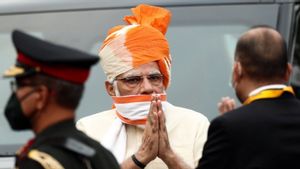JAKARTA - After falling for two days, reports of cases of COVID-19 infection in India again broke records, in the last 24 hours there were reports of 360.960 cases of daily infections.
The figure is worrisome, as it is far from the previous record on Monday, where there were 352.991 reported cases of infection daily. Meanwhile, the number of deaths due to COVID-19 in India has reached 201.187 people with a total infection case of more than 18 million cases.
The condition is of concern to health authorities, doctors, health observers, and the public. India's health system is nearing peak load, there is no room left in hospitals.
Many patients have to be refused by health services, so they die at home, in ambulances, in vehicles, and even outside the clinic. The oxygen crisis has exacerbated the COVID-19 tsunami in India.
In Surat City, Gujarat State, nearly 150 people are rejected from the hospital every day, said Dr. Hiral Shah, president of the state-level Indian Medical Association.
"Our hospital is overwhelmed with our own population and we are running out of oxygen so we cannot accept those who come from the surrounding area", he said, cited from CNN.
"The (oxygen) supply is uncertain, the hospital doesn't know what will happen today or tomorrow", he added.

Scientists are still doing genome sequencing on the Indian variant, and no official data has been published, which means it is not yet known exactly how contagious the variant is, or what additional risks it might pose.
But given the speed and severity of the second wave that devastated India, countries are taking no chances, with many imposing travel bans and suspending flights from India.
Countries that share borders with India are also aware of this condition, such as Pakistan, Nepal, Myanmar, Bhutan, and Bangladesh. Some borders are relatively non-strict, with people crossing frequently for their daily activities.
Nepal, which borders northeast India, has seen the number of cases start to decline in February, with newly identified cases ranging from 50 to 100 every day.
However, infections erupted in mid-April as India's second wave accelerated and daily cases now run in the thousands. The outbreaks have so far centered on the capital Kathmandu and Nepalgunj in Lumbini province.
"The increase in cases is partly due to Nepalis returning from India, said Dr. Krishna Prasad Poudel, director of Nepal's Division of Epidemiology and Disease Control.
SEE ALSO:
Bangladesh, to the east of India, also saw its cases start to surge in March, reaching a peak in early April that far outpaced all previous waves. But cases have fallen, with authorities imposing strict lockdowns and suspending air travel. On Monday, the country closed its border with India for two weeks, although trade will continue.
Likewise with Pakistan which borders India to the west. Cases of COVID-19 infection started to increase in early March, accelerating towards the end of the month as the outbreak in India. The country reported 201 deaths on Wednesday, the highest in a day, with more than 88.000 cases still active.
The Pakistani government called on the military to help enforce COVID-19 guidelines and imposed a number of new restrictions including closing outdoor dining, fitness centers, and schools until 12th grade. The country also bans all tourism and travel between provinces during the Eid holidays.
The English, Chinese, Japanese, Arabic, and French versions are automatically generated by the AI. So there may still be inaccuracies in translating, please always see Indonesian as our main language. (system supported by DigitalSiber.id)













